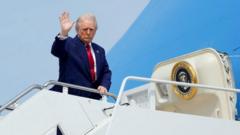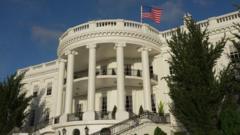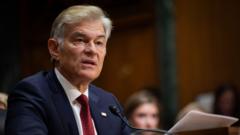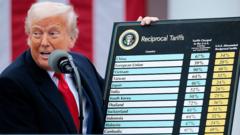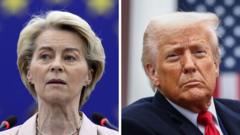**The ongoing trade war escalates as neither the US nor China shows signs of backing down, impacting agricultural exports and global supply chains.**
**Escalating Trade Tensions: US and China Lock Horns Over Tariffs**

**Escalating Trade Tensions: US and China Lock Horns Over Tariffs**
**As tariff battles escalate, both nations double down on protectionism**
Despite the looming threat of further economic fallout, neither the US nor China appears willing to retreat from their standoff over tariffs. American exports to China are facing a staggering 34% price hike, significantly impacting sectors such as agriculture, where producers are grappling with prior tariffs of 10% to 15%. Analysts express deep concern regarding the ripple effects on global supply chains, as the intertwining nature of international trade could lead to widespread economic distress.
China’s announcement of "resolute countermeasures," timed strategically late on a Friday holiday, suggests a calculative approach to minimize domestic panic while conveying a firm stance against US tariffs. Such timing and China’s reluctance to negotiate could indicate that a resolution may be more challenging to achieve than anticipated.
President Xi Jinping's actions during this announcement further illustrate the solid posture China is adopting; while US officials scrutinize the developments, Xi was seen planting trees, signaling a nonchalant approach amidst rising tensions. The possibility emerges that China might pivot to strengthen ties with alternative trade partners, potentially sidelining the US.
This tit-for-tat exchange of tariffs presents obstacles not only for American businesses but also for everyday consumers, who will face augmented prices stemming from these international economic skirmishes. As the situation escalates, it remains to be seen whether dialogue can pave the way for a resolution, or if the entrenched positions of both nations will lead to further isolation and imbalance in global trade dynamics.
China’s announcement of "resolute countermeasures," timed strategically late on a Friday holiday, suggests a calculative approach to minimize domestic panic while conveying a firm stance against US tariffs. Such timing and China’s reluctance to negotiate could indicate that a resolution may be more challenging to achieve than anticipated.
President Xi Jinping's actions during this announcement further illustrate the solid posture China is adopting; while US officials scrutinize the developments, Xi was seen planting trees, signaling a nonchalant approach amidst rising tensions. The possibility emerges that China might pivot to strengthen ties with alternative trade partners, potentially sidelining the US.
This tit-for-tat exchange of tariffs presents obstacles not only for American businesses but also for everyday consumers, who will face augmented prices stemming from these international economic skirmishes. As the situation escalates, it remains to be seen whether dialogue can pave the way for a resolution, or if the entrenched positions of both nations will lead to further isolation and imbalance in global trade dynamics.



